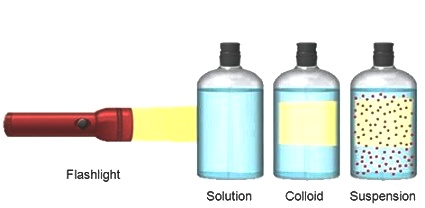PDF chapter test TRY NOW
Scattering of light:
The interaction of light with objects around us gives rise to several spectacular natural phenomena. The blue colour of the sky, deep-sea watercolour, the reddening of the sun at sunrise and the sunset are some of the excellent phenomena we are familiar with.
We have discussed about the scattering of light by colloidal particles in the previous sections. The path of a beam of light is not visible while passing through a proper solution. But, through a colloidal solution, its path becomes visible where the size of the particles is relatively higher.

Scattering of light
Tyndall Effect:
The earth's atmosphere is a heterogeneous blend of minute particles. These particles carry smoke, tiny water droplets, suspended particles of dust and molecules of air. When a light beam strikes such fine particles, the beam's path becomes visible.
The light reaches us after being getting reflected diffusely by these particles. The scattering of light by the colloidal particles is the phenomenon that gives rise to the Tyndall effect, which you have studied in previous classes.

Tyndall Effect
This phenomenon is noticed when a fine beam of sunlight pierces a smoke-filled room through a small hole. So, the scattering of light makes the particles visible. Tyndall effect can also be seen when sunlight travels through a canopy of a dense forest.
Hereabouts, tiny water droplets in the mist scatter light. The colour of the scattered light mainly depends on the size of the scattering particles. Very fine particles mainly scatter blue light while particles of larger size scatter light of greater wavelengths if the size of the scattering particles is high enough, when the scattered light may even appear white.
